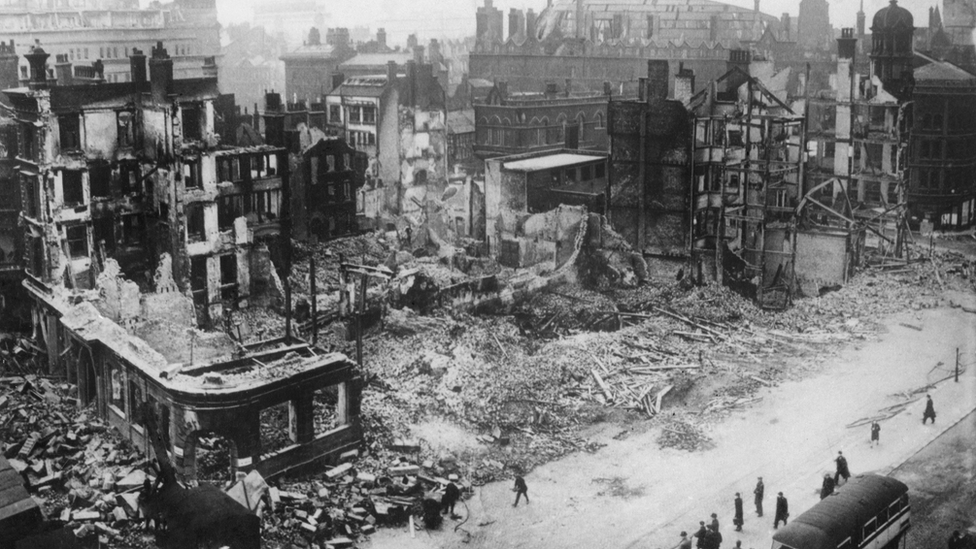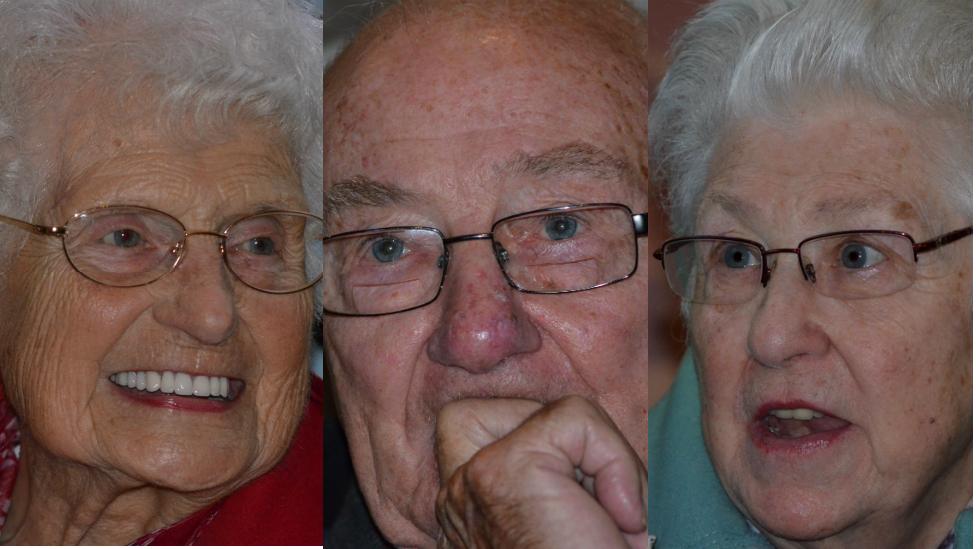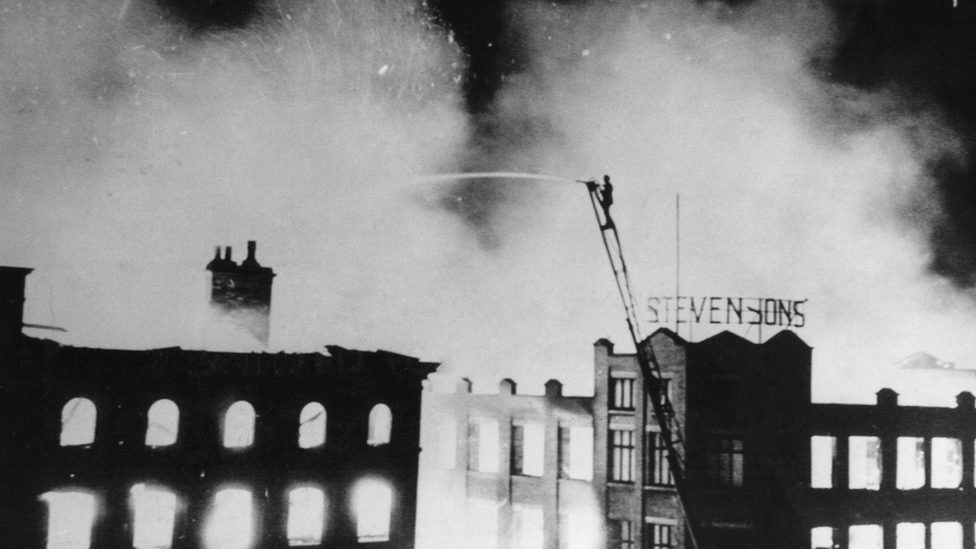Manchester's devastating Christmas Blitz
- Published

The fires burned during the night of 22 December
As the Christmas of 1940 approached, German bombs rained down on Manchester city centre, killing hundreds of people and causing widespread destruction.
The so-called Christmas Blitz on the evening of 22 December reduced shops and buildings in St Ann's Square to ruins. The area around Deansgate near the cathedral was badly damaged, with a large bomb crater marking the road.
War Office photographer William Lockeyear took a series of images as buildings burned and masonry came tumbling down. The sky glowed orange as huge clouds of smoke billowed and thickened the air with dust. The pungent whiff of burning wood and the smell of powdered brick and plaster lingered.
Two waves of bombs pounded the city from 20:00 GMT on 22 December, only ending at 06:00 the next day.
Among the buildings hit in the heart of the city were Manchester's Free Trade Hall, the Royal Exchange, Smithfield Market, Cheethams Hospital, the Gaiety Theatre and St Ann's Church.
In total, 684 people died and a further 2,300 were wounded with districts to the north and east of the city badly affected, notably Cheetham Hill and Strangeways. At least 8,000 homes were made uninhabitable.
During the war as a whole, 1,400 civilians died in Manchester, so the raid represents almost half those killed. One in 10 of was under the age of 13.

A general view of the bomb damage in Manchester following the Christmas Blitz raids

A general scene of damage caused to Manchester city centre taken from the top of a building in Deansgate

Blitz survivors Susan Jones, Geoffrey Whittle and Doreen Herring

Doreen's story: I saw a pilot pause overhead and roar off
Seven-year-old Doreen Herring saw a Luftwaffe plane flying overhead as her family, from Pendleton, made their way to an air raid shelter.
They looked up and saw the pilot pause and then the plane sped ahead without dropping a bomb. "I am convinced it was because he could see us," she said.
Her father, George Pinder, refused to go to the air raid shelter and said: "If a bomb wants to get me, it will get me."
They were terrified of seeing if their house had been damaged when leaving the shelter. "Next door to us had been bombed to bits.
"All you wanted to do afterwards was to have a cup of tea."
She remembers there were a lot of children's funerals and the disgusting smell of rotten food after the bombing ended. "You could breathe again," she added, when the raids were over.

People coped by cooking using broken furniture in their gardens that they would burn on fires to create heat. If water mains were damaged, they would drink water from bowsers.
Father George Street, 34, who had spent all night helping people amid the bombing, died when the church of St Augustine in York Street took a direct hit. A collage of mangled chalices and church items is now on the wall of the new church in All Saints Place, off Oxford Road.
The current incumbent, Father Dave Lannon, said Father Street had offered his usual chair to another priest. Had he stayed there "he would have survived".
Geoffrey Whittle was 12 when he was evacuated twice from the home he shared in Gorton with his grandmother to the leafy suburbs of Bramhall.
However, he hated it there - his hosts imposed a "cruel" regime of being forced to eat the previous day's leftovers - and he was back in Gorton when the raid took place.
He remembers closing all the curtains when the air raid sirens went off and being scared of any light showing through.
"We were all settled in this brick shelter about 500 yards away from the house in Greave Street, Gorton. Then this man would play the piano accordion and sing war songs.
"Everyone would be singing along and I don't remember getting any sleep in the shelter."

Susan's story: I thought I was indestructible
Susan Jones, 16 at the time, was shopping in Ancoats as the bombs started dropping. She watched pieces of shrapnel hitting the buildings and sparking and bouncing off.
She took refuge in the shelter near the Avro Manchester factory, where she was working as a riveter and driller on Lancaster bombers. The sight of several cockroaches scuttling across the shelter led her to volunteer for fire warden duties on the factory roof.
"The shrapnel started coming down and one bit hit a wall of one of the big mills," she said. "I could see sparks and I was hugging the wall to try and stay safe. I wasn't frightened because of my age at the time, I thought I was indestructible and found it dead exciting."
One of her relatives was hit in the face by an incendiary device during the raids, but survived.
"It was a dreadful thing," she said of the Christmas Blitz. "I looked up at the sky and it seemed like everything was on fire. There was an acrid smell of burning and from the guns. The sky was all orange and yellow it looked like the fireworks I'd seen at Belle Vue when I was younger."


Firefighters use a ladder during a night raid in Manchester in 1941
Historian Ian Kikuchi, from the Imperial War Museum North in Trafford, said there had been few fatalities in Manchester until the Christmas Blitz.
"The heaviest bombing previously had been in the East End of London," he said. "The Luftwaffe launched bombings across Britain as they were trying to disrupt food supply and were targeting ports and centres of distribution."
Mr Kikuchi said the Germans bombed Coventry in November 1940 because of its strategic position in heavy industry, but the focus soon shifted to other cities across Britain.
He said the raids had been anticipated by British intelligence. "What was surprising was the intensity of the raids," he said.
"The Luftwaffe saw Manchester as an adjunct to the port of Liverpool, which was a major industrial centre."
- Published29 December 2010